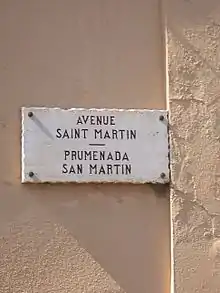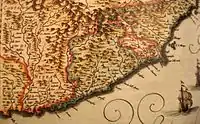Monégasque dialect
Monégasque (Ligurian: munegàscu, Italian: monegasco, French: monégasque) is the dialect of Genoese spoken in Monaco, where it is considered a national language, even though it is not the official language of the country (Monaco's official language is French).
| Monégasque | |
|---|---|
| munegascu | |
| Native to | Monaco |
| Ethnicity | 8,400 have Monegasque nationality (2016)[1] |
Native speakers | (ca. 20 cited for 1950)[2] nearly extinct, but taught in school as a heritage language |
| Language codes | |
| ISO 639-3 | – |
| Glottolog | mone1238 |
| Linguasphere | 51-AAA-cha |

Monégasque is officially taught[3] in the schools of Monaco, but is the native language of only a handful of people. In Monaco-Ville, some street signs are printed in both French and Monégasque.[4]
Classification
Forming a part of the Western Romance dialect continuum, Monégasque shares many features with the Genoese dialect. Though similar to the dialect of Ventimiglia, it does differ from the Menton dialect. It shares similarities also with the Niçard dialect of the Occitan language.
Monegasque, like all other Ligurian language variants, is derived directly from the Vulgar Latin of what is now northwestern Italy and southeastern France and has some influence in vocabulary, morphology and syntax from French and related Gallo-Romance languages, but most words are more like Italian.
Before the annexation of the County of Nice to France in 1860, the Niçois spoke a dialect very similar to Monégasque.[5]
Speakers
It is spoken in addition to French by Monégasques, mostly within the small nation of Monaco. As Monégasques are only a minority in Monaco, the language was threatened with extinction in the 1970s.
However, Monégasque is now being taught in schools, and its continuance is regarded as secured. In the old part of Monaco, street signs are written in Monégasque and French.
Relation to Italian

Italian is also a major language in Monaco. Italian nationals make up some 20% of Monaco's 35,000 permanent residents. Italian was the official language of Monaco when it was a protectorate of the Kingdom of Sardinia-Piedmont from 1814 to 1861, leaving a legacy in some Monégasque words.[6] Indeed, for a long time after the Renaissance, Monaco was the most westerly part on the Mediterranean coast of the Republic of Genoa.
During the fascist occupation in 1942–43, the Principality of Monaco was incorporated into Italy and Monégasque was again considered an Italian dialect. After World War II there were nearly 10,000 Italians in Monte Carlo, and some of them (descendants of the followers of Giuseppe Garibaldi, who were forced to move from Nice to the Kingdom of Italy after 1861) even spoke Monégasque fluently.
Orthography
Monégasque orthography generally follows Italian principles, with the following exceptions:
- ⟨ü⟩ represents [ʏ]
- ⟨œ⟩ represents [e]
- ⟨ç⟩ represents [s]
Samples
Below is an excerpt from the Monégasque national anthem, written by Louis Notari. In addition, there is an older French version of the anthem; its lyrics have a different meaning. The choice between the two forms is generally subject to the occasion and the circumstance.
Despœi tugiù sciü d'u nostru paise
Se ride au ventu, u meme pavayùnDespœi tugiù a curù russa e gianca
E stà l'emblema, d'a nostra libertàGrandi e i piciui, l'an sempre respetà
The following is a Monégasque rendering of the Hail Mary:[7]
Ave Maria,
Tüta de graçia
u Signù è cun tü
si benedëta tra tüt'ë done
e Gesü u to Fiyu è benejiu.
Santa Maria, maire de Diu,
prega per nùi, pecatùi
aùra e à l'ura d'a nostra morteAMEN. (Che sice cusci.)
External links
References
- 2016 census
- Raymond Arveiller (1967) Etude sur le Parler de Monaco. Comité National des Traditions Monégasques.
- L’enseignement de la Langue Monégasque (PDF), archived from the original (PDF) on 2007-10-07
- "Society". Monaco-IQ. Retrieved 6 September 2012.
- Gubbins, Paul; Holt, Mike (2002). Beyond Boundaries: Language and Identity in Contemporary Europe. Multilingual Matters. p. 91. ISBN 978-1-85359-555-4.
- History of Monaco
- "Pater Noster in Monégasque". Archived from the original on 2008-05-09. Retrieved 2008-10-16.